 |
|
 |
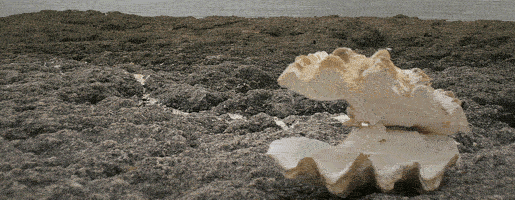
OCEANIA IS A CONCEPTUAL PLACE consisting of inhabited islands within
the Pacific Ocean, but there is no consensus on which islands are to
be included in the concept. I have spent more than a decade living on
some of these islands and so I have thought about the concept quite a
bit. Here's my 2 cents worth then. As you can see in the map on the right
there is a lot of 'wet real estate' to consider. What would be the value
in this conceptual place, one might ask? To me as an inhabitant of this
place the value is in an economic and political union to begin protecting
our place in the world. Think of the European Union for example. An
Oceanic Union would be a good thing for all the peoples of Oceania. What
we have that needs protecting includes vast resources: fishing, transport,
minerals, energy potentially, and human resources. An emerging concern
for most of the world, and especially Oceania, is sea level rise. We really
need a political union to meet this challenge, as the rest of the world is
in denial and has consistently chosen a pathway which represents a serious
threat to the survival of communities within Oceania. The economy of Oceania is
also under threat from the rest of the world. As it stands right now, each
of the small nations within Oceania is no match for any international corporation
and thus periodically become economic slave states to corporate greed. There
have been bloody battles fought over resources throughout Oceania, and this has
limited development. Of course limited development has benefitted Oceanic citizens
who historically have not considered development to be a core cultural value. We
need a political union to bring about an Oceanic form of development that
is better suited to our unique environment and cultures. Elements that are required
to feed into the new development model include a regional higher education system
with a well-developed (academic) economic development research institute which is not
dominated by non-Oceanic paradigms, and bottom-up development initiatives brought in
from indigenous Oceanic communities. With the strength of an economic
and political Oceanic Union it would be possible to both raise the consciousness of
the citizens of Oceania and bring benefits of our 5,000 year history to
the rest of the world.
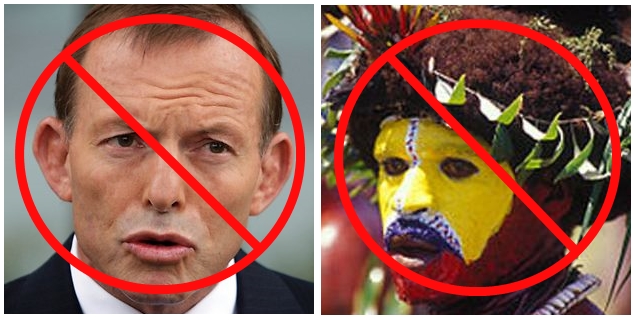 The elephant in the room is Australia. With only 23 million people living
there, it is no population match for it's neighbor Indonesia (237,424,363).
Yet is has historically emerged as the dominant military force in the area.
That's a problem for Oceania because Australia is not an island, it's just
way too big (and thus very sparsely populated) to share much of anything
with the concerns of island people. But Australia is still about 10 times
more people that the combined 902 islands which are clearly part of any
analysis of "what gets included in Oceania". This brings in one of my
conclusions - we need to get Indonesia to take a larger role in the area.
The nation of Indonesia has over 17,000 islands and over 900 are inhabited.
But an Oceanic Union would be difficult to manage if 99% of it's population
was just the one country. So we have to exclude Australia and Indonesia from
a conceptual Oceanic Union. A huge benefit would be if Indonesia were to cast
itself as the dominant trading partner with an Oceanic Union in order to
balance the outsized influence of Australia in the region. Another very large
population in Oceania is New Guinea (PNG 7,059,653). It is the second largest
island on earth (Greenland is larger) and was connected to Australia until the end
of the last glacial period (around 10,000 years ago). It presents a cultural quandry
to the conceptual Oceania because, like Australia, it's indigenous population
is ancient (up to 40,000 years old) but that population has been marginalized for a
few centuries now. There are some 1,000 languages spoken on the island, and about
40 to 50 tribal groups there remain uncontacted by the rest of the earth even now
because of the difficult terrain. Colonization by European nations was followed
in the 1960's-70's by division into an independent eastern half (Papua New Guinea),
and a western half incorporated into Indonesia. As I see it the island has more to
gain as a neighbor to the Oceanic Union than as a member of it. So I have excluded
New Guinea because it is so messed up that the Union couldn't function with it.
The elephant in the room is Australia. With only 23 million people living
there, it is no population match for it's neighbor Indonesia (237,424,363).
Yet is has historically emerged as the dominant military force in the area.
That's a problem for Oceania because Australia is not an island, it's just
way too big (and thus very sparsely populated) to share much of anything
with the concerns of island people. But Australia is still about 10 times
more people that the combined 902 islands which are clearly part of any
analysis of "what gets included in Oceania". This brings in one of my
conclusions - we need to get Indonesia to take a larger role in the area.
The nation of Indonesia has over 17,000 islands and over 900 are inhabited.
But an Oceanic Union would be difficult to manage if 99% of it's population
was just the one country. So we have to exclude Australia and Indonesia from
a conceptual Oceanic Union. A huge benefit would be if Indonesia were to cast
itself as the dominant trading partner with an Oceanic Union in order to
balance the outsized influence of Australia in the region. Another very large
population in Oceania is New Guinea (PNG 7,059,653). It is the second largest
island on earth (Greenland is larger) and was connected to Australia until the end
of the last glacial period (around 10,000 years ago). It presents a cultural quandry
to the conceptual Oceania because, like Australia, it's indigenous population
is ancient (up to 40,000 years old) but that population has been marginalized for a
few centuries now. There are some 1,000 languages spoken on the island, and about
40 to 50 tribal groups there remain uncontacted by the rest of the earth even now
because of the difficult terrain. Colonization by European nations was followed
in the 1960's-70's by division into an independent eastern half (Papua New Guinea),
and a western half incorporated into Indonesia. As I see it the island has more to
gain as a neighbor to the Oceanic Union than as a member of it. So I have excluded
New Guinea because it is so messed up that the Union couldn't function with it.
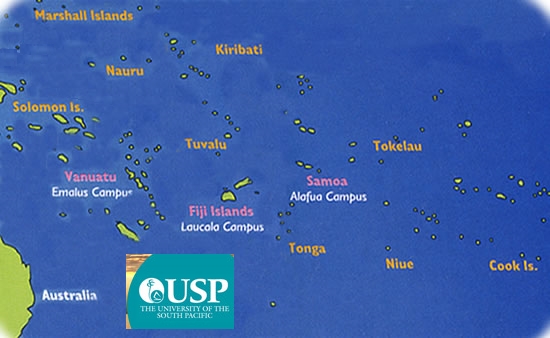 There are a couple of possible organizing principles to consider when an
analysis of Oceania is made. The first is the cultural lens. As I have
detailed in the home page, there was a Lapita culture which originated in
the Taiwan area and developed into the greater Polynesian culture. Along
with Polynesia, we have the potentially much older Melanesian culture, and
the somewhat younger Micronesian culture. The map above has these three
cultures drawn into regions, but of course this is an oversimplification.
The other organizing framework I draw upon is the University of the South
Pacific which is based in Suva, Fiji. USP has campus on twelve island nations
and this consortium makes a good framework. (The school itself, well sadly I
don't think it is a very good school by my own standards, a background including
ten universities as a student and ten more as a faculty member.) Fiji presents a small
problem for this consideration, due to the outsized dominance of tourism there,
a pretty odd political history combined with the current quirky government. But
this group of nations which participate in USP as basically the only accredited
post-secondary school in the region still makes a good framework. Here is a list
of the countries in Oceania with their USP status, cultural heritage, and population:
There are a couple of possible organizing principles to consider when an
analysis of Oceania is made. The first is the cultural lens. As I have
detailed in the home page, there was a Lapita culture which originated in
the Taiwan area and developed into the greater Polynesian culture. Along
with Polynesia, we have the potentially much older Melanesian culture, and
the somewhat younger Micronesian culture. The map above has these three
cultures drawn into regions, but of course this is an oversimplification.
The other organizing framework I draw upon is the University of the South
Pacific which is based in Suva, Fiji. USP has campus on twelve island nations
and this consortium makes a good framework. (The school itself, well sadly I
don't think it is a very good school by my own standards, a background including
ten universities as a student and ten more as a faculty member.) Fiji presents a small
problem for this consideration, due to the outsized dominance of tourism there,
a pretty odd political history combined with the current quirky government. But
this group of nations which participate in USP as basically the only accredited
post-secondary school in the region still makes a good framework. Here is a list
of the countries in Oceania with their USP status, cultural heritage, and population:
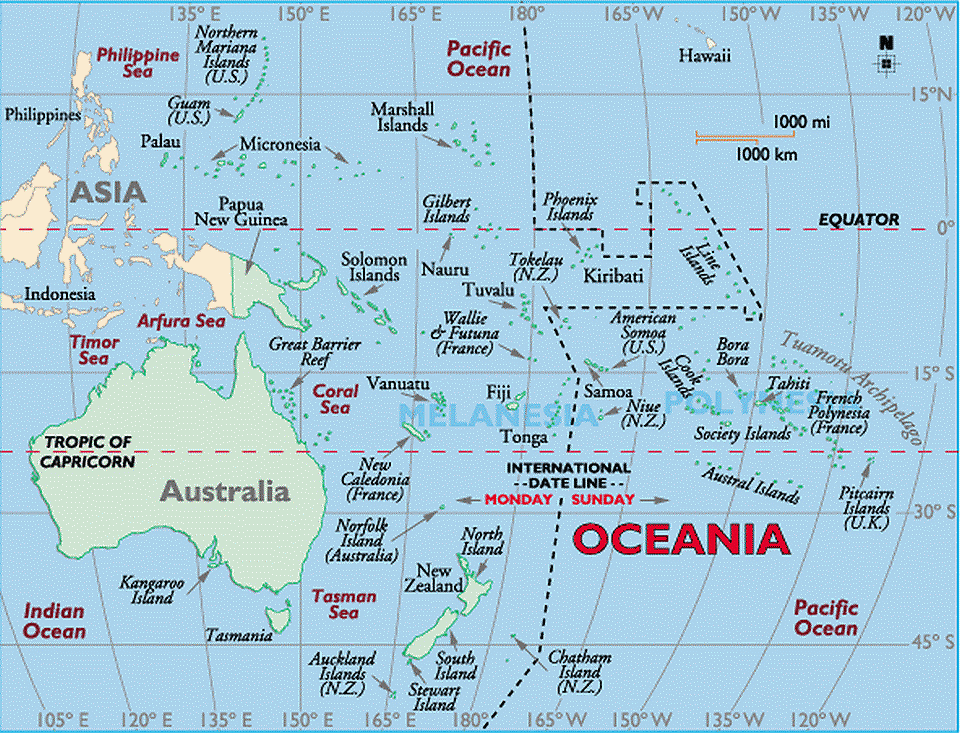
USP member countries Py-Cook Islands (NZ) = 10,777, 15 small islands Ml-Fiji = 849,000, 332 islands of which 110 are inhabited Mc-Kiribati = 98,000, 32 atolls and one raised coral island Mc-Marshalls = 62,000, 24 atolls, 1,156 individual islands Mc-Nauru = 13,635, one island Py-Niue (NZ) = 1,269, one island Py-Samoa = 179,000, 2 inhabited islands, 8 small islets Ml-Solomons = 523,000, 922 islands, 347 are inhabited Py-Tokelau (NZ) = 1,368, 3 atolls Py-Tonga = 104,000, 176 islands of which 52 are inhabited Py-Tuvalu = 12,373, three reef islands and six atolls Ml-Vanuatu = 243,304, 82 islands of which 65 are inhabited Not part of USP Ml-New Caledonia (Fr) = 240,390, 36 islands Mc-Micronesia = 135,869, 607 islands of which 65 are inhabited Mc-Palau = 19,409, over 300 islands of which 8 are inhabited Py-Easter Island (Chile) = 5,761, one island Py-French Poly (Fr) = 257,847, about 130 islands Py-Wallis & Futuna (Fr) = 15,585, 23 islands, 2 are inhabited
This group I would consider as the 18 island nations which would have to be included in any conceptual Oceania. That is 2,773,000 people on 902 inhabited islands out of a total count of about 2703 islands. That's not a very large number of people for such a vast area of the earth, and that is the crux of our problem in Oceania; we are so easily marginalized by the rest of the world despite the huge area of the planet we inhabit. We need some more clout. So that brings in two larger players: Hawaii and New Zealand. Added to that list and ordered by population you get:
Py-New Zealand = 4,465,900, 33 islands of which 12 are inhabited Py-Hawaii (US) = 1,360,301, 8 inhabited islands Ml-Fiji = 849,000, 332 islands of which 110 are permanently inhabited Ml-Solomons = 523,000, 922 islands of which 347 are inhabited Py-French Poly (Fr) = 257,847, about 130 islands Ml-Vanuatu = 243,304, 82 islands of which 65 are inhabited Ml-New Caledonia (Fr) = 240,390, 36 islands Py-Samoa = 179,000, 2 inhabited islands and eight small islets Mc-Micronesia = 135,869, 607 islands of which 65 are inhabited Py-Tonga = 104,000, 176 islands of which 52 are inhabited Mc-Kiribati = 98,000, 32 atolls and one raised coral island Mc-Marshalls = 62,000, 24 atolls, comprising 1,156 individual islands Mc-Palau = 19,409, over 300 islands of which 8 are inhabited Py-Wallis & Futuna (Fr) = 15,585, 23 islands of which 2 are inhabited Mc-Nauru = 13,635, one island Py-Tuvalu = 12,373, three reef islands and six atolls Py-Cook Islands (NZ) = 10,777, 15 small islands Py-Easter Island (Chile) = 5,761, one island Py-Tokelau (NZ) = 1,368, 3 atolls Py-Niue (NZ) = 1,269, one islandThis brings the total to 8,599,201 people. Still a small number when compared to the nations we need to stand beside (stand up to?), but I would posit this 20 member Oceanic Union has enough clout to get recognition for the essential issues that need attention. It would include 1,347,980 Polynesians, 1,855,694 Melanesians (inflated by Fiji non-Melanesians, mostly Indians), and 328,913 Micronesians for a total number of Pacific Islanders of 3,532,587 who still live on their islands plus an uncalculated number of Pacific Islanders who now live in Hawaii and New Zealand (I guess it could be calculated, but suffice to say that it would probably end up being a slight majority of this conceptual Oceanic Union).
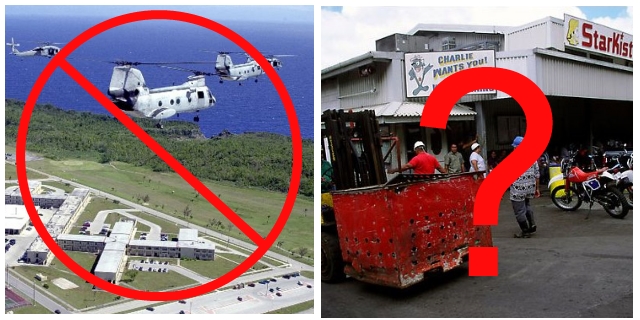 So how would this work, adding two very large countries into the mix? I don't
really see a problem with New Zealand, as it is perhaps the most cool country
on the whole earth. There is a large and relatively intact Polynesian culture
found there (Maori) of about 600,000 and the rest of New Zealand has come to
provide a decent level of respect for them. I believe that New Zealand would
welcome the opportunity to shepherd an Oceanic Union because it gives them a
way to lend more stability to the region, which is essentially their shared
responsibility with Australia. Also the country already has a very significant
population of Pacific Island people (with roots from outside New Zealand). The
USA is the real problem with this version of an Oceanic concept. If we exclude
all of the USA territories (as I am doing with Guam and American Samoa) then I
believe we are passing up a great opportunity to help the Pacific islanders who
live in those places. Hey, what's that about American Samoa? All right, here is
my view of that place. If it wasn't for Chicken of the Sea, Bumble Bee, and Star
Kist tuna, there wouldn't be any American Samoa. Well two of those have closed
already, so now it may just be a matter of time before the USA is ready to get
out of the South Pacific imperialist business. It is really sad, the state of
things in American Samoa, and it reminds me of how things were for French parts
of the South Pacific before France realized they needed to get out of the South
Pacific imperialist business a few decades ago. But the transition from American
Samoa to whatever comes next is going to be really messy. Again I think
that an Oceanic Union could potentially be really helpful in that transition, but
not with Am Sam as a full member up front. As for Guam, well it is really just an
American Navy/Air Force Base. The original inhabitants were exterminated, and those who are
considered to be Guam's indigenous population (Chamorro) are mostly involved in
the Japanese tourism business or supporting the US military. I don't see the USA
allowing Guam to be a part of the Oceanic Union, nor will they ever give up their
Navy facilities. As for the other "unincorporated territories" (Northern Mariana
Islands, Wake Island, and American Samoa) this may not apply to them indefinitely.
So how would this work, adding two very large countries into the mix? I don't
really see a problem with New Zealand, as it is perhaps the most cool country
on the whole earth. There is a large and relatively intact Polynesian culture
found there (Maori) of about 600,000 and the rest of New Zealand has come to
provide a decent level of respect for them. I believe that New Zealand would
welcome the opportunity to shepherd an Oceanic Union because it gives them a
way to lend more stability to the region, which is essentially their shared
responsibility with Australia. Also the country already has a very significant
population of Pacific Island people (with roots from outside New Zealand). The
USA is the real problem with this version of an Oceanic concept. If we exclude
all of the USA territories (as I am doing with Guam and American Samoa) then I
believe we are passing up a great opportunity to help the Pacific islanders who
live in those places. Hey, what's that about American Samoa? All right, here is
my view of that place. If it wasn't for Chicken of the Sea, Bumble Bee, and Star
Kist tuna, there wouldn't be any American Samoa. Well two of those have closed
already, so now it may just be a matter of time before the USA is ready to get
out of the South Pacific imperialist business. It is really sad, the state of
things in American Samoa, and it reminds me of how things were for French parts
of the South Pacific before France realized they needed to get out of the South
Pacific imperialist business a few decades ago. But the transition from American
Samoa to whatever comes next is going to be really messy. Again I think
that an Oceanic Union could potentially be really helpful in that transition, but
not with Am Sam as a full member up front. As for Guam, well it is really just an
American Navy/Air Force Base. The original inhabitants were exterminated, and those who are
considered to be Guam's indigenous population (Chamorro) are mostly involved in
the Japanese tourism business or supporting the US military. I don't see the USA
allowing Guam to be a part of the Oceanic Union, nor will they ever give up their
Navy facilities. As for the other "unincorporated territories" (Northern Mariana
Islands, Wake Island, and American Samoa) this may not apply to them indefinitely.
 So what about Hawaii? It's a part of the USA, right? The 50th state and all that.
Not so according to some legal scholars. The takeover of the Nation of Hawaii was
wrong and the USA did apologize for it during the Bill Clinton presidency. The
president at the time of the takeover (Grover Cleveland) ruled against it and he
ordered the US military to give it back. They ignored him. What? Yes the land of
the free and home of the brave has some skeletons in our collective closet. Did you
know that president Andrew Jackson once ignored a Supreme Court decision? That's
right, the Cherokee Nation won a Supreme Court decision against the USA, which ruled
that the state of Georgia must give most of the state back to the Indians. Jackson
said "It's their decision, let's see them enforce it then." When it comes to this
kind of ugly, hideous imperialism, the USA has blood on it's hands. There is
no way to hide from this truth. So what about the vote? Didn't Hawaii get the chance
to choose accession to the USA? Not exactly. There was a vote but it did not give
the voters any choice but accession. It was either become a part of the USA or, well
there was no other choice on the ballot. Clearly the choice was accede OR ELSE! But
we need to acknowledge the reality of the Hawaiian situation at that time. Hawaii was
colonized by Polynesians around 1100 AD and before that time it appears that there
was another people living in the Hawaiian islands. The colonizers were of a large
stature with a culture we could call "Ali'i Culture" or sometimes called "Kapu Culture".
The Ali'i were the fierce warriors and Kapu means forbidden. The basis of their life
was to make war and to forbid people from doing things. The Ali'i were not nice people.
The islands were ruled by several individual Ali'i, who periodically killed their
neighbors, killed small children for various reasons, and begat children with their
own cousins and sisters (incest). Archeologists have shown that the Hawaiian civilization
had peaked in population some centuries before contact, and was therefore in decline.
It is not clear why there was an earlier decline, but we do know most Hawaiians did
not survive the contact period. The islands were never united under a single ruler
until Kamehameha I was able to obtain weapons from the British. Sharks tooth swords
were no match for a canon. Any notion that Hawaii was an idyllic paradise where all
lived in peace and prosperity before the overthrow of it's rightful monarchy is pure
fantasy. Although the Kamehameha dynasty lasted less than 100 years, it was the rightful
monarchy at the time of the overthrow and this cannot be disputed. That the overthrow
was illegal cannot be disputed, the US government has admitted it formally. But by the
standards of Polynesian kingdoms, less than 100 years is not very long at all. Tongan
kingdoms were thousands of years each. So left alone one can only wonder what would
have happened in Hawaii. There might have been a ruler like Tonga's Tupou I, who gave
the kingdom to God instead of becoming a part of the UK. Or Hawaii could have turned out
like Rapa Nui (Easter Island) where the decline nearly wiped out the whole civilization.
So what about Hawaii? It's a part of the USA, right? The 50th state and all that.
Not so according to some legal scholars. The takeover of the Nation of Hawaii was
wrong and the USA did apologize for it during the Bill Clinton presidency. The
president at the time of the takeover (Grover Cleveland) ruled against it and he
ordered the US military to give it back. They ignored him. What? Yes the land of
the free and home of the brave has some skeletons in our collective closet. Did you
know that president Andrew Jackson once ignored a Supreme Court decision? That's
right, the Cherokee Nation won a Supreme Court decision against the USA, which ruled
that the state of Georgia must give most of the state back to the Indians. Jackson
said "It's their decision, let's see them enforce it then." When it comes to this
kind of ugly, hideous imperialism, the USA has blood on it's hands. There is
no way to hide from this truth. So what about the vote? Didn't Hawaii get the chance
to choose accession to the USA? Not exactly. There was a vote but it did not give
the voters any choice but accession. It was either become a part of the USA or, well
there was no other choice on the ballot. Clearly the choice was accede OR ELSE! But
we need to acknowledge the reality of the Hawaiian situation at that time. Hawaii was
colonized by Polynesians around 1100 AD and before that time it appears that there
was another people living in the Hawaiian islands. The colonizers were of a large
stature with a culture we could call "Ali'i Culture" or sometimes called "Kapu Culture".
The Ali'i were the fierce warriors and Kapu means forbidden. The basis of their life
was to make war and to forbid people from doing things. The Ali'i were not nice people.
The islands were ruled by several individual Ali'i, who periodically killed their
neighbors, killed small children for various reasons, and begat children with their
own cousins and sisters (incest). Archeologists have shown that the Hawaiian civilization
had peaked in population some centuries before contact, and was therefore in decline.
It is not clear why there was an earlier decline, but we do know most Hawaiians did
not survive the contact period. The islands were never united under a single ruler
until Kamehameha I was able to obtain weapons from the British. Sharks tooth swords
were no match for a canon. Any notion that Hawaii was an idyllic paradise where all
lived in peace and prosperity before the overthrow of it's rightful monarchy is pure
fantasy. Although the Kamehameha dynasty lasted less than 100 years, it was the rightful
monarchy at the time of the overthrow and this cannot be disputed. That the overthrow
was illegal cannot be disputed, the US government has admitted it formally. But by the
standards of Polynesian kingdoms, less than 100 years is not very long at all. Tongan
kingdoms were thousands of years each. So left alone one can only wonder what would
have happened in Hawaii. There might have been a ruler like Tonga's Tupou I, who gave
the kingdom to God instead of becoming a part of the UK. Or Hawaii could have turned out
like Rapa Nui (Easter Island) where the decline nearly wiped out the whole civilization.
But Hawaii was not able to set it's own course and that was a bad thing. Maybe this could explain the problems we have in Hawaii today: rampant corruption, dysfunctional government, miserable education, widespread homelessness, horrible traffic, sky-high living costs, a drug epidemic, a lack of affordable housing, and a shortage of Indian restaurants. Clear enough to me the status quo in Hawaii is not working. The US government doesn't know what to do, except that we got Pearl Harbor and we will not give it up. There are dozens of Hawaiian Sovereignty movements but they won't cooperate and many are composed of tinfoil-hat conspiracy theorists. I believe that an Oceanic Union is just the thing to get people talking to each other in Hawaii, to get the Hawaiian's back to their roots. And it's just the thing to get the US government back on the right track with the Hawaiian situation. Admitting the mistake is not enough, some tangible action is called for. Here it is. Allow Hawaii to become a founding member of the Oceanic Union, separate from it's identity as part of the USA. There's a topic, now discuss.
Now why should I be so concerned about Hawaii? Why did I live there for 7+ years if things are so messed up there? It feels like home to me, and there is a reason why. A few years ago a member of my family (now deceased) told me that I am a relative of the husband to the last Queen of Hawaii. His name was John Owen Dominis, and he was the third cousin of my great-great grandfather Ezra b.11/23/1847 d.3/7/1902. Put that in your pipe and smoke it.